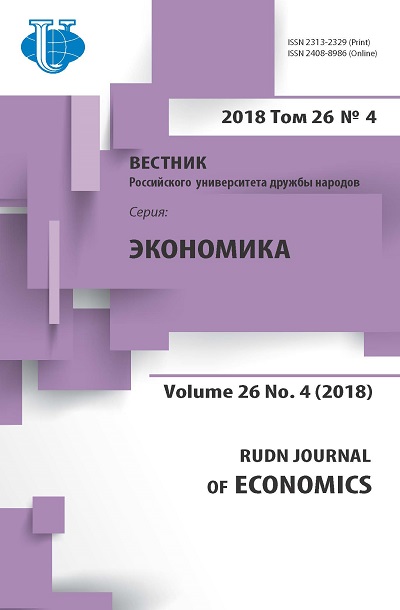Recreational agglomeration as a historically established trend in the process of urbanization in recreational areas
- Authors: Voitehovsky D.V1
-
Affiliations:
- V.I. Vernadsky Crimean Federal University
- Issue: Vol 26, No 4 (2018)
- Pages: 630-642
- Section: REGIONAL ECONOMY
- URL: https://journals.rudn.ru/economics/article/view/20756
- DOI: https://doi.org/10.22363/2313-2329-2018-26-4-630-642
Cite item
Full Text
Abstract
We substantiated the uniqueness of recreational agglomerations as a separate functional type and considered features of the process of urbanization in recreational areas with a secondary type of appearance of recreational functions. It is spoken in detail about existing scientific literature on the problems and indicated the existing “white spots” which requiring deeper scientific study. The main methodological principles are indicated, on the basis of which a subsequent deep analysis of the process of agglomeration in recreational areas was carried out. The peculiarities of the urbanization process in recreational areas with the secondary type of recreational functions appearance are considered. Basis on this we presented the author’s scheme which reflects the evolution of the urbanization process in the recreational area. The much attention is given to interrelations between the rapid development of recreational functions and agglomeration in the region. The author’s scheme of the features of the formation process of the planning structure of recreational settlements is presented, on the basis of which the analysis of the main transformations of the planning structure of coastal recreational cities in the socio-economic conditions characteristic of the historical past of the Russian Federation was carried out. We studied the main problems and internal conflicts of recreational agglomerations as complex polyfunctional systems. The nature and sources of hotbeds of tension in urban recreational centers are considered, on the basis of which their classification is derived. After we presented a detailed analysis of the identified types of conflicts and gives examples of hotbeds typical for large urban recreational centers. Based on the selected types, we give some recommendations aimed at overcoming the main problematic situations of recreational agglomerations in conclusion we indicated the possibilities of alternative ways of development of the urbanization process in recreational areas, which allow to prevent a high level of social tension in the system of settlement of recreational areas.
About the authors
Dmitrii V Voitehovsky
V.I. Vernadsky Crimean Federal University
Author for correspondence.
Email: voitehovskydmitry@mail.ru
graduate student, V.I. Vernadsky Crimean Federal University, Taurida Academy
8 Vernadsky Ave., Simferopool, 295007, Russian FederationReferences
- Alaev Eh.B. (1983). Social’no-ehkonomicheskaya geografiya: ponyatijno-terminologicheskij slovar’. Moscow: Mysl’ Publ. 350 p. (In Russ.)
- Vedenin Ju.A. (1980). Processy razvitija territorial’nyh rekreacionnyh system. Social’no-jekonomicheskie i geograficheskie aspekty issledovanija territorial’nyh rekreacionnyh system. Pp. 16—30. (In Russ.)
- Vojtekhovskij D.V. (2017). Teoreticheskie aspekty izucheniya sistemy rasseleniya v rekreacionnom rajone. Turizm i rekreaciya: fundamental’nye i prikladnye issledovaniya: trudy XII Mezhdunarodnoj prakticheskoj konferencii. MGU imeni M.V. Lomonosova, geograficheskij fakul’tet, Moskva, 25—26 aprelya 2017. Moscow: ANO “Dialog kul’tur” Publ. Pp. 274—279. (In Russ.)
- Galuh G.A., Romanova V.A. (1990). K voprosu ob obrazovanii i funkcionirovanii rekreacionnyh aglomeracij. Ekonomichna ta sotsial’na geografiya. Pp. 108—111. (In Russ.)
- Davidovich V.G. (1971). Rasselenie v prigorodnyh zonah. Voprosy geografii. No. 87. Pp. 5—43. (In Russ.)
- Davidovich V.G., Horev B.S. (1961). Goroda-sputniki. Gosudarstvennoe izdatel’stvo geograficheskoj literatury: sb. st. Pp. 10—12. (In Russ.)
- Kapralov E.G. (2005). Geoinformatika. Moscow: Akademiya Publ. P. 480. (In Russ.)
- Kudrjavcev V.B. (1981). Geograficheskie aspekty modelirovanija sistemy rasselenija Krymskogo rekreacionnogo rajona: dis. … kand. geogr. nauk. Simferopol’. P. 242. (In Russ.)
- Kuznetsova О.V (2017). Goroda kak ob”ekty regional’noj politiki: opyt Rossii i Evropy. RUDN Journal of Economics. Vol. 25 (4). Pp. 566—574. (In Russ.)
- Luk’janova L.G., Cybuh V.I. (2004). Rekreacionnye kompleksy: uchebnoe posobie. Kiev: Vishha shkola Publ. P. 346. (In Russ.)
- Oborin M.S. (2013). Regional’nyj analiz izuchenija rekreacionnyh sistem. Vestnik Permskogo universiteta. No. 2. Pp. 35—42. (In Russ.)
- Ocenka chislennosti naseleniya na 1 yanvarya 2018 goda po municipal’nym obrazovaniyam Krasnodarskogo kraya. URL: http://krsdstat.gks.ru/wps/wcm/connect/rosstat_ts/krsdstat/resources/b98c9c804 4d9a869b7d6bfde4cdebdf4/%D0%9E%D1%86%D0%B5%D0%BD%D0%BA%D0%B0+%D1 %87%D0%B8%D1%81%D0%BB%D0%B5%D0%BD%D0%BD%D0%BE%D1%81%D1%82%D0%B8_01.01.2018.htm (data obrashcheniya: 27.03.2018). (In Russ.)
- Chugunova N.V., Polyakova T.A., Lihnevskaya N.V. (2013). Razvitie sistemy gorodskogo rasseleniya Belgorodskoj oblasti. Geografiya i prirodnye resursy. No. 1. Pp. 112—118. (In Russ.)
- Chuanglin F., Danlin Y. (2017). Urban agglomeration: An evolving concept of an emerging phenomenon. Landscape and Urban Plannin. Vol. 162. Pp. 126—136.
- Ebenezer H. (1902). Garden cities of To-Morrow. London: Swan Sonnenschein & Co.
- Geddes P. (1915). Cities in evolution: An introduction to the town-planning movement and the study of cities. London: Williams and Norgate.
- Gibbs J. (1963). The evolution of population concetration. Economic Geography. Vol. 39. No. 2. Pp. 119—129.















